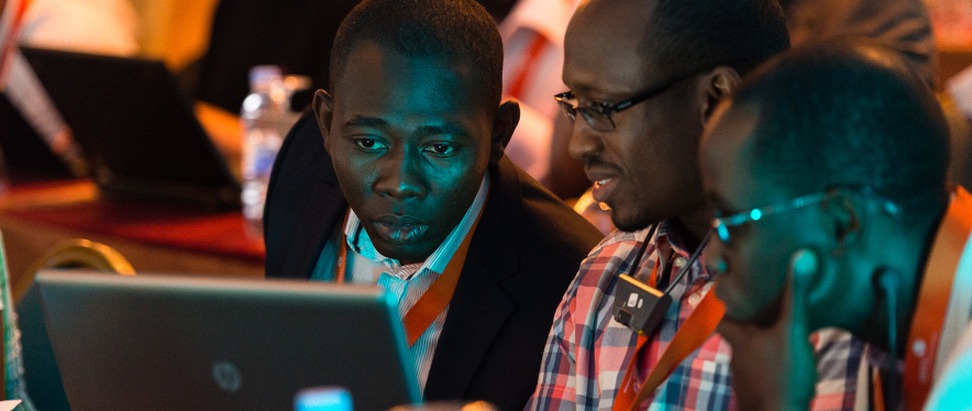We’re fighting for a world where everyone can access and develop a connected, borderless, permission-less, limitless Internet that creates opportunity and progress for all.
But we can’t get there alone.
A connected world is only built through collaboration with a wide range of extraordinary partners. That’s why we’re working together with businesses, governments, local communities, and individual donors to drive change at the scale needed.
Over the past two decades of our work, we’ve found that everywhere the Internet has flourished, it has done so thanks to the existence of skilled and passionate people who work to build and ensure the network keeps running and information is created and shared.
It’s really all about people.
People work with other experts to learn more, understand network architecture and traffic management, who have created local, regional, and international partnerships for development. They’re creating the tools, forums and services that create local demand.
Partnerships That Work
Connecting the world is at the core of the Internet Society’s mission. In emerging economies connections are built and last through local solutions amplified by global reach.
To see this in action look no further than Internet exchange points (or IXPs for short).
From our experience, we know that IXPs are at the center of a more robust community of people that help make the Internet work and are a key part in driving local content.
IXPs, at the most basic level, are switches, routers, ports, cables, and servers that allow local IP-based network providers (e.g., Internet service providers, national research and engineering networks, government networks, and mobile networks) to interconnect with each other and exchange traffic.
In other words, network providers in a single country can share data traffic directly, instead of having to connect through an exchange point in a foreign country.
In theory at least, this means that any country that establishes an IXP, or improves the IXPs it has in place, will have faster and lower-cost Internet service.
In short, IXPs keep local traffic local.
The great thing about IXPs is that all this can start from a pretty modest technical base.
IXPs don’t have to be elaborate when they get going.
The London Internet Exchange, to take one example, began in 1994 with a single donated piece of networking equipment and five local Internet Services Providers as members. Today, London has over 400 members and is one of the biggest IXPs in the world. LINX started with people working together to build something. Technology does not walk by itself and success relies on those partnerships that pull communities together.
The Internet Society and other organizations around the world (the African Union, APIX, Af-IX, Euro-IX, LAC-IX, LACNIC, Packet Clearing House) can help countries obtain equipment and provide training.
The really important part is what comes next.
On occasion, and despite all best intentions, implementing an IXP can stall.
Why?
Sometimes the people do not come together or they do not have enough technical bandwidth or participants may not be fully invested in developing the IXP
When things like this happen, it’s a reminder that the technical infrastructure—routers and switches—is only a part of Smart Internet Development, and not the most important. It cannot stand on its own.
Small-Scale Efforts Can Yield Massive Dividends
Partnerships do stand on their own and we blogged about a collaborative partnership in Ecuador in October 2013.
LACNIC, Cisco, and the Internet Society worked with Aeprovi, the ISP association in Ecuador, to support IXPs in Quito and Guayaquil. Before the IXPs in these two cities were developed, Ecuador’s connectivity was impacted by expensive international traffic costs. Local Internet traffic was not exchanged locally. IXPs in Quito and Guayaquil were built out in 2001, and interconnected in 2007 and local traffic began to be exchanged locally. LACNIC and ISOC partnered to provide IPv6 and BGP routing trainings.
The results have been a stronger more technically capable community of experts, managing better networks, and reduced local connectivity costs due to local traffic being exchanged in country.
And, recently, with the African Union, AfricNIC, ISOC, and the local Internet Community, an IXP went “live” in Namibia. Experts spent time in Best Practices workshops understanding the benefits of bringing this architecture to the country. They spent time in Technical Assistance workshops and learned more about sustaining the IXP, peering, and better traffic management. The community pulled together.
If there is one shared theme across all the components of Internet Development – physical, human and governance infrastructures – it’s that small-scale efforts can yield massive dividends. We have seen the impact an IXP can make on a local community: faster traffic delivery, better quality of service, lower costs, and greater uptake by users of services. Smart Development is as much about developing and cultivating the resources already at hand as it is about creating new ones.
As we mentioned at the beginning of this blog, no one person, organization, or business, does it alone.
Partnerships create those critical human networks that sustain communities, bring in new technology, and keep building out and improving networks one partnership at a time.

